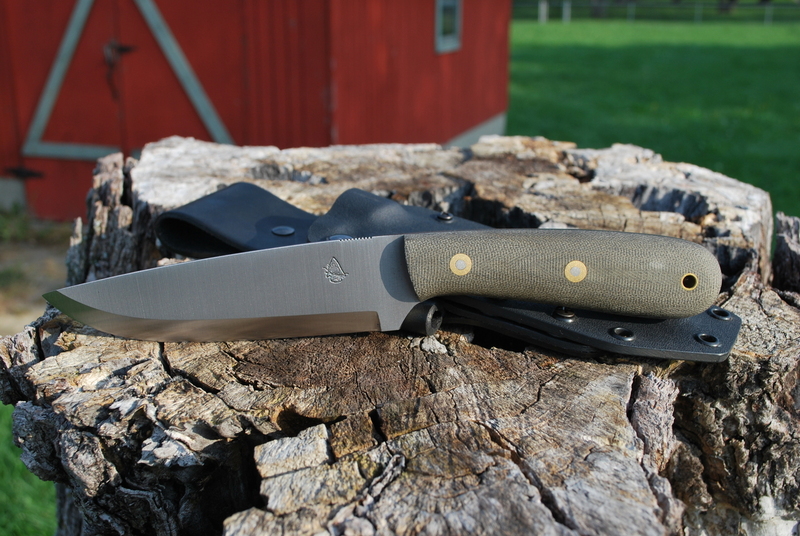Cutting Tool: Can You Cut It?

By: John Anderson
You’re alone. It’s twilight when you pull yourself onto the riverbank, and you’re wet and cold. All your gear has been washed downstream. Maybe your boat capsized while shooting a rapid, or you were fly fishing and took a nasty fall. No matter the reason, you’re here and you’ve got nothing but what was strapped to your body. For your sake, let’s hope your inventory includes a good cutting tool.
In this month’s installment of the Five C’s of Survival, we’ll explore cutting tools and why they are vital to your survival in a self-reliance situation.
Whenever you venture into the woods, a knife of some kind is a must. The kind of knife you choose may vary, but any cutting tool is better than nothing. This blade will give you the ability to improvise many other things that will help you survive, like making a fire or building a shelter. You’d be hard pressed to reproduce a good cutting tool in the wilderness, so you’d better bring one in with you.
SIZE
Because you’re relying on this knife as the single tool that could save your life in a worst-case scenario, you don’t want to choose something wimpy. I recommend a blade length of at least 4 inches (5-6 is better). In the width department, the thicker, the better. You’re going to be using this as a cutting, chopping, splitting, prying, and possibly digging tool, so don’t get a little knife. At the same time, you don’t need to feel like Crocodile Dundee with a machete strapped to your thigh. Take your time, compare your options, and choose the right knife for you.
BLADE
This knife needs to hold a keen edge and be easily resharpened. It needs to be strong and durable. That means it needs to be made out of high-carbon steel. Stainless steel just won’t cut it, pun intended. It’s crunchy on the outside and chewy in the middle, and the first time you try to pry apart a thick log, you’ll thank me for insisting on high-carbon over stainless.
The blade also needs to be fixed, not folding. A folding pocket knife is a great tool for everyday use, but if it’s your only knife in a self-reliance situation, then your only tool starts out broken in half, and it usually gets worse from there. In fact, not only should the knife’s blade be solid, it should be “full-tang.” That means it should extend all the way through the handle to the bottom as one, complete piece. This greatly increases the strength of the blade and makes it less likely to break out of the handle.
In a self-reliance situation, if you can have one tool serve multiple purposes, you’re winning. If you carry an inexpensive ferrocerium rod (like the flint in your lighter, but much bigger and thicker) and have a hard edge on the back your knife, combined with some practice, you’re going to be able to produce fire. In order to effectively throw sparks off the ferro rod, the knife’s spine should have a hard 90-degree edge. If the spine of the blade is rounded on its edges, it may be more comfy on your thumb, but it won’t make many sparks.
HANDLE
The handle of your knife can vary widely and should suit your personal preferences. It needs to fit well in your hand and have a good texture for grip and fine carving tasks. The only requirement is that it be solid and firmly attached to your knife’s full-tang blade. Hollow-handled survival knives are mostly for Hollywood.
RECOMMENDED KNIFE OPTIONS
Here are several knives that fit the bill. First, a great knife if you’re on a tight budget is the Mora Bushcraft Black (Amazon link: http://www.amazon.com/Morakniv-Bushcraft-Tactical-4-3-Inch-Sandvik/dp/B009O01H0Y/). It features a 4.3 inch blade made of good, high-carbon steel. It will throw sparks off of your ferro rod, and best of all, it’s only about $40. At that price, you are compromising the full-tang requirement, and the blade isn’t as beefy as we might like, but it also won’t hurt your wallet too badly.
For a stouter choice, I recommend the Ka-Bar Becker BK2 (Amazon link: http://www.amazon.com/Ka-Bar-Becker-BK2-Campanion-Fixed/dp/B001N1DPDE/). This knife is a real bruiser, with a 5.5 inch blade that is a full 1/4 of an inch thick! It will handle almost any self-reliance cutting task with ease. The blade is full-tang and the handle is sturdy, so this is a great choice at about $70, and is the overall best buy in this list.
If you want a purpose-made bushcraft knife, made out of incredible 01 Tool steel, and featuring a special Scandinavian grind that will slice through just about anything, look no further than the Pathfinder 1 Knife (http://www.thepathfinderstore.com/plsk1-pathfinder-1-knife/). Made by Battle Horse Knives to the personal specifications of self-reliance expert Dave Canterbury, the PLSK1 is a fantastic choice and a tool you’ll be able to hand down to your grandkids, but you’ll have to part with $300 of your dollars to acquire it.
CARRY A KNIFE
In conclusion, there are a lot of things about a knife that can make it more suited for self-reliance tasks. However, at the end of the day, the best knife is the one you have on you. If you don’t already carry some kind of knife on a daily basis, I challenge you to begin doing so. It will serve you well in a variety of situations, no matter what kind of knife you carry, and just might help save your life!

John Anderson spent his youth in the woods of North Carolina and the jungles of South-east Asia. Having been raised by missionary parents, John has spent time in Mexico, Canada, and the Philippines, climbing trees, hunting game, and getting dirty. His father spent the time to teach him the ways of the woods, building fires, hunting deer, hiking, and camping. He received further training in the outdoors through the Outdoor Education program at Montreat College and from many trips on the trails and waterways of the Appalachian Mountains with his band of brothers.



